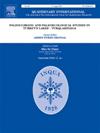Exploring ecological evolution and driving forces in arid desert oases: A case study of the Ejina Oasis in China
IF 1.9
3区 地球科学
Q3 GEOGRAPHY, PHYSICAL
引用次数: 0
Abstract
Arid regions cover approximately 30 % of the Earth's landmass with sparse vegetation. These regions are ecologically fragile and highly sensitive to environmental change. A comprehensive understanding of the factors driving vegetation change in arid regions can provide valuable insights for their vegetation restoration and conservation. This study focused on the Ejina Oasis, a representative case of oasis in the arid region. We analyzed the spatial and temporal changes of normalized difference vegetation index (NDVI) from 2000 to 2020 using the Theil-Sen Median trend analysis and Mann-Kendall test. A structural equation model was applied to elucidate the mechanisms underlying vegetation change in the Ejina Oasis. Our results indicated that the overall NDVI of the Ejina Oasis remains low, and vegetation primarily concentrated around rivers and lakes. Since 2000, NDVI has shown a continuous increase, with annual growth rates of 0.0069/year for NDVIMEAN and 0.0071/year for NDVIMAX. The vegetation growth occurred mainly in the middle reaches of the West River and the lower reaches of the East River. The vegetation around the East Juyan Sea and Swan Lake showed a significant expansion. Water availability and human activities played significant roles in driving vegetation change. Our studies demonstrated that vegetation in arid regions is affected by a range of ecological factors beyond water availability. Furthermore, the application of structural equation model enabled the identification of key drivers of vegetation change. By examining these drivers at different stages, our study provided a new perspective for understanding the mechanism of vegetation change in arid regions.
干旱区荒漠绿洲生态演化与驱动力研究——以额济纳绿洲为例
干旱地区约占地球陆地面积的 30%,植被稀少。这些地区生态脆弱,对环境变化高度敏感。全面了解干旱地区植被变化的驱动因素可为植被恢复和保护提供有价值的见解。本研究以干旱地区具有代表性的埃吉纳绿洲为研究对象。我们利用 Theil-Sen 中值趋势分析和 Mann-Kendall 检验分析了 2000 年至 2020 年归一化差异植被指数(NDVI)的时空变化。应用结构方程模型阐明了额济纳绿洲植被变化的内在机制。结果表明,额济纳绿洲的总体净植被指数仍然较低,植被主要集中在河流和湖泊周围。自 2000 年以来,NDVI 呈持续增长趋势,NDVIMEAN 的年增长率为 0.0069/年,NDVIMAX 的年增长率为 0.0071/年。植被增长主要发生在西河中游和东河下游。东居延海和天鹅湖周围的植被有明显的扩展。水供应和人类活动在植被变化中发挥了重要作用。我们的研究表明,干旱地区的植被除了受水源影响外,还受到一系列生态因素的影响。此外,结构方程模型的应用还有助于确定植被变化的主要驱动因素。通过在不同阶段研究这些驱动因素,我们的研究为理解干旱地区植被变化的机制提供了一个新的视角。
本文章由计算机程序翻译,如有差异,请以英文原文为准。
求助全文
约1分钟内获得全文
求助全文
来源期刊

Quaternary International
地学-地球科学综合
CiteScore
5.60
自引率
4.50%
发文量
336
审稿时长
3 months
期刊介绍:
Quaternary International is the official journal of the International Union for Quaternary Research. The objectives are to publish a high quality scientific journal under the auspices of the premier Quaternary association that reflects the interdisciplinary nature of INQUA and records recent advances in Quaternary science that appeal to a wide audience.
This series will encompass all the full spectrum of the physical and natural sciences that are commonly employed in solving Quaternary problems. The policy is to publish peer refereed collected research papers from symposia, workshops and meetings sponsored by INQUA. In addition, other organizations may request publication of their collected works pertaining to the Quaternary.
 求助内容:
求助内容: 应助结果提醒方式:
应助结果提醒方式:


